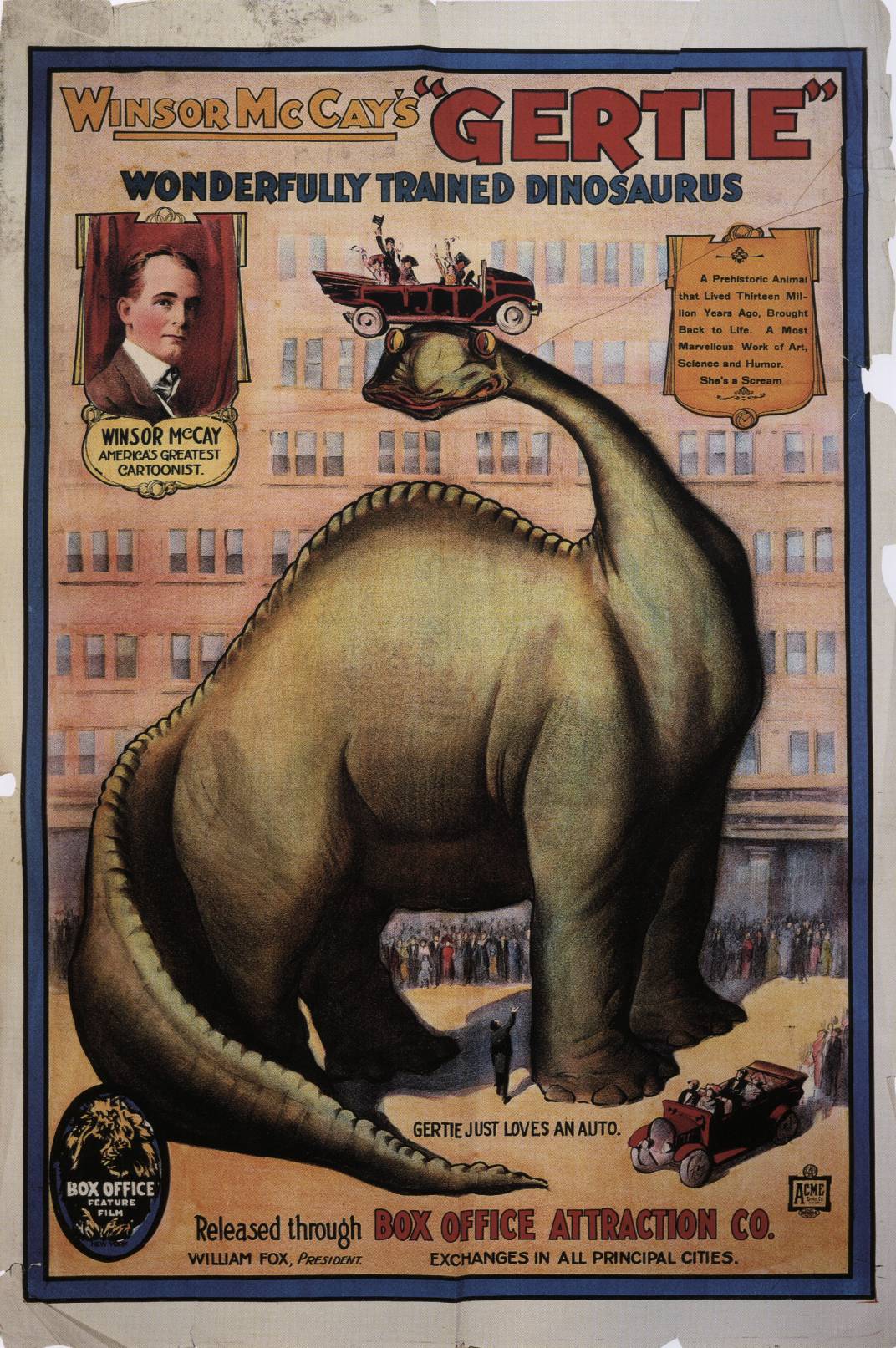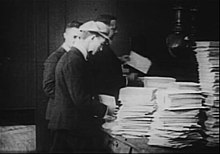Gertie the Dinosaur is a 1914 American animated short film by Winsor McCay. Although not the first animated film, as is sometimes thought, it was the first cartoon to feature a character with an appealing personality. The appearance of a true character distinguished it from earlier animated “trick films”, such as those of Blackton and Cohl, and makes it the predecessor to later popular cartoons such as those by Walt Disney and Max Fleischer. The film was also the first to be created using keyframe animation. The film has been selected for preservation in the United States National Film Registry, and was named #6 of The 50 Greatest Cartoons of all time in a 1994 survey of animators and cartoon historians by Jerry Beck.

Vaudeville

Gertie the Dinosaur was originally created to be used in McCay’s vaudeville performances. McCay started performing “chalk talks” on vaudeville in 1906, as a sideline to his regular newspaper cartooning. In 1911, he began presenting animated films on stage, first an animation of Little Nemo in Slumberland, then How a Mosquito Operates. Plans for Gertie were announced in 1912. The episode of McCay’s newspaper comic In the Land of Wonderful Dreams published in newspapers on September 21, 1913 showed the reader some of the creatures from the upcoming film: a “dinosaurs”, a sea serpent and a four-winged lizard. In January 1914, the drawings were photographed by Vitagraph Studios. The first presentation of the film was at the Palace Theater in Chicago on February 8, 1914; later performances were at the Hammerstein Theater in New York City.
The performance consisted of McCay interacting with Gertie, a cartoon dinosaur based on the Brontosaurus skeleton in the American Museum of Natural History.McCay would stand on stage in front of a projection screen, dressed in a tuxedo and wielding a whip. He would call Gertie, who appeared from behind some rocks. He then instructed her to perform various tricks, similar to a circus act. He would appear to toss a prop apple to her – McCay palmed the apple while Gertie caught an animated copy of it. Gertie was also seen to swallow a large stump, play with a Mastodon, and drink an entire lake dry. At one point, McCay would scold Gertie for misbehaving, at which she would begin to cry. For the finale, McCay disappeared behind the screen just as a cartoon version of him climbed onto Gertie’s head and rode off.
Movie theaters
McCay’s employer, William Randolph Hearst, was displeased with McCay’s success outside of the newspapers, and used his contractual power to reduce McCay’s stage activities. In late 1914, William Fox, offered to market Gertie the Dinosaur to moving-picture theaters. McCay accepted, and extended the film to include a live-action prologue and intertitles to replace his stage patter. This is the version of the film generally seen today; the original animation comprises roughly 5 minutes of the entire 12-minute film.
The film features McCay with several of his cartoonist friends, such as George McManus (creator of Bringing Up Father), Roy McCardell, and Thomas A. Dorgan. As the film opens, they are “on a joy ride”, when their automobile suffers a flat tire in front of a museum. The cartoonists enter the museum, and see a “Dinosaurus” skeleton. McCay bets McManus a dinner that he can “make the Dinosaurs live again by a series of hand-drawn cartoons”. He then spends six months making “ten thousand cartoons”; when McManus visits, McCay shows him the drawings, although an assistant trips and scatters a large pile of them over the floor (a gag also used in the Little Nemo film). The scene then shifts to a dinner party with the group of cartoonists. McCay begins by sketching a single drawing of Gertie. Someone complains that “your bet was that you could make it move”, following which the film shifts to the original animated Gertie. McCay, through intertitles, tells Gertie to come out and bow, and continues through the same interaction as in the vaudeville show (although the “apple” that McCay throws to her is now referred to as a pumpkin, which was more appropriate for the size of Gertie’s mouth). The film concludes with the group telling George (McManus) to pay for the dinner.
Production
Gertie the Dinosaur was produced before the introduction of later time-saving techniques such as cel animation. To create the film, McCay himself drew thousands of frames of Gertie on individual 6.5 x 8.5 inch sheets of rice paper. He hired neighbor and art student John A. Fitzsimmons to draw the backgrounds. Fitzsimmons carefully re-traced the rocks, lake and tree from a master drawing onto each sheet of rice paper.
In creating the film, McCay came up with a number of techniques that would later become standard in the animation industry. He used registration marks to keep the background aligned from frame to frame, so that it did not appear to “swim”, as often happened in early cartoons. He avoided some repetitious work by re-using drawings, in what would later be called cycling. He devised what he called the “McCay Split System”, the first occurrence of keyframe animation. Rather than draw each frame in sequence, he would start by drawing Gertie’s key poses, and then go back and fill in the frames between. McCay was also very concerned with accurate timing and motion; he timed his own breathing to determine how to animate Gertie’s breathing, and included subtle details such as the ground sagging beneath Gertie’s great weight.
McCay was very open about the techniques that he developed. During production of Gertie, he showed all the details to a visitor who claimed to be writing an article about animation. The visitor turned out to be John Randolph Bray, who later patented many of McCay’s methods and tried to sue him. McCay prevailed, however, and received royalties from Bray for several years thereafter.
Around 1921, McCay worked on a second animated film featuring Gertie, titled Gertie on Tour. The film would have Gertie visiting New York and Washington, D.C., bouncing on the Brooklyn Bridge and attempting to eat the Washington Monument, among other scenes. The film may have been designed for performance on the vaudeville stage; it exists today only in fragments and concept sketches.
A plagiarization of Gertie, from roughly 1915, was distributed for many years, incorrectly identified as McCay’s film. Donald Crafton suggests that this other Gertie may have been created by Bray Productions, based on its graphical style.
McCay’s son Robert, along with Disney animator Richard Huemer, recreated the original vaudeville performance for the Disneyland television program in 1955.

Dinosaur Gertie’s is a soft serve ice cream location at Disney’s Hollywood Studios in Walt Disney World, Florida. The building, an example of Programmatic architecture, is shaped like Dinosaur Gertie. The shop is located on Echo Lake.





















